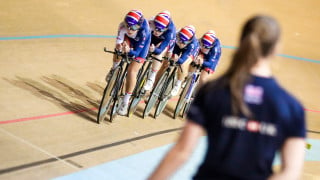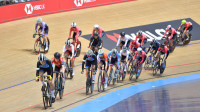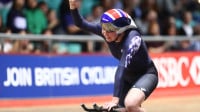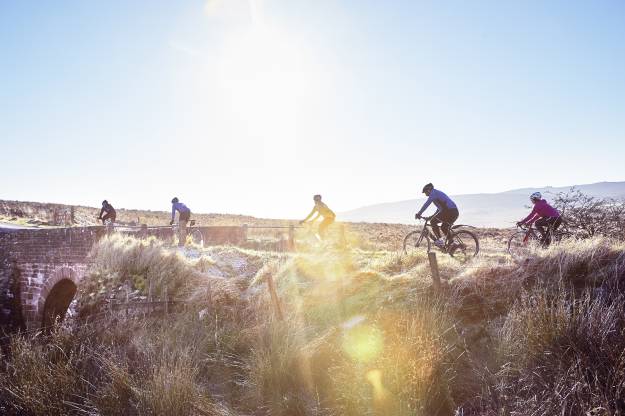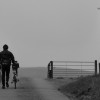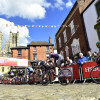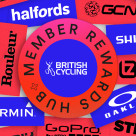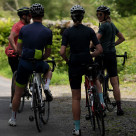If you’ve worked your way through the accreditation process at one of the UK’s six indoor velodromes, what can you expect at your first SQT (Structured Quality Training) Session?
Our Starting Track Cycling article gave you some top tips which will have helped you progress through your track’s accreditation process. During the process, especially the latter stages, you will have been introduced to some of the drills and exercises used in SQT (Structured Quality Training) sessions but booking on for that first one can still be daunting. In this article we give you some technique and kit tips and describe some of the typical drills you’ll take part in.
Bike
If you have worked through your accreditation on a hire bike, you might now be wanting to buy a track bike of your own. Make sure you check through the bike requirements for your track as there will be requirements for gearing, tyres, crank length and other specifications.
If you have your own track bike, get into the habit of checking it over before every session. Pay particular attention to tyre condition and pressure, chain tension and wheel nuts.
Kit
You won’t require any additional kit to when you were working through your accreditation. However, if you’re using your own bike, you should have a track pump and the basic tools, allen keys and 15 mm spanner, to check and maintain it.
Some riders like to loosen up on rollers before an SQT and learning to ride rollers is part and parcel of riding on the track. A towel is also handy for wiping off any sweat on you and off your bike and tyres before going on the track.
Food/drink
Avoid eating a main meal in the 2-3 hours before an SQT. If you’re feeling low on energy a banana an hour before can usually be tolerated. With most sessions lasting 2 hours, a gel halfway through is a good idea and, with indoor tracks tending to be warm, you should drink between each exercise.

Look
Learned during your first taster session and the most important coaching point is to always look before you move on the track. Constant observation and awareness of other riders is crucial for both safety and success on the track.
Listen
Always listen to the instructions and any feedback from the coach. Even if you think you’re familiar with a drill or exercise, pay close attention to the briefing as one coach might well have a different interpretation of it to another. If you have any questions, ask and then join the back of the line where you’ll be able to observe how the exercise works.
Warm-up
An SQT will typically begin with a warm-up .The coach will give you the all-clear to get up on the track and you and the other riders should form up on the blue line. A line will begin to form and you should ride high on the track, wait for it to come underneath and then join the back. Do not circle on the black and ride up to the back of the line from there. If you are on the blue and the line of riders come up behind you, move up and join onto the back of them. Do not force them to ride over the top of you. Again, observation is key.
Ride a steady and consistent pace. The coach will inform you if they require you to change off the front every lap or every half lap. Do not suddenly increase the pace when you get on the front but don’t slow the line up either. Ride predictably, keeping close to the rider in front and constantly observing further ahead in the line. Do not overreact to any movement and never underlap the rider in front.
Generally the warm-up will progressively increase in pace. This will sometimes be on the instruction of the coach but often just happens. Occasionally the coach may bring the line down onto the black as the speed increases. You may also warm-up riding as two lines changing in pairs and switching to “through and off” as the pace increases. Listen to the coach’s instructions.
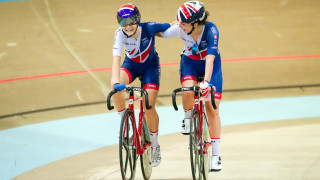
Taking half laps
For taking half laps, you will ride at recovery pace as two lines on the blue line half a lap apart. You won’t change and it’s up to the first rider in each group to ensure that then groups remain the correct distance apart. If your group is ahead, don’t suddenly slow up but instead ride slightly higher on the track to establish the correct gap. The coach will have informed you how many riders are taking the half laps, up to four, and, on the whistle or bell, that number of riders will look, drop down off the front onto the black and begin riding hard across to the group ahead. You’ll typically change every half lap and should be aiming to keep the group together. As you catch the back of the group, the front rider will give a shout of “up!”, lead the group up the track and, as you’ll be travelling faster than the group on the blue line, overshoot above it. You’ll then slow and drop onto the rear of the group. Listen to and watch the coach as they may change the number of riders chasing as the drill progresses.
Taking full laps
Taking full laps is the same as taking half laps apart from there is only one recovery line on the blue. You’ll go off the front of this line and catch the rear of it. Taking a lap is a longer effort so pace it and be considerate of the other riders in your chasing group. Make sure the line on the blue remains at recovery pace.
Hunters
There are lots of variants of this drill and the numbers involved will vary, so listen carefully to the coach as they describe it. Typically you’ll start as two recovery lines on the blue, half a lap apart, as with taking half laps. On the whistle, one version has four riders from the front of each group dropping down to the black and chasing the group ahead. They don’t change and, when they come to the rear of the group, only the first two riders swing up and join the rear. The remaining two riders continue under the group on the black and the front two riders from the group on the blue drop down and join them. Observation is key to success in this drill. You need to be aware of and react to the riders coming underneath. Miss them and you face a hard chase to get back on.
Intervals
For intervals, the coach will get you to spread out around the track. You’ll then alternate periods of hard riding and periods of recovery. When to start and end each effort is signalled with a whistle. Faster riders should ride higher on the track with slower riders lower down. Keep looking, especially when moving to overtake other riders and don’t undertake.
Six-Day points race
A great misnomer. It doesn't last six days, there are no points and it’s not a race. You’ll begin by riding as one line at recovery pace on the blue. The coach will then display 5 laps on the lap board. You’ll continue to ride on the blue at recovery pace until the board displays 2 laps. The whole line will then drop down to the black and the pace will increase. With a lap to go, the bell will sound and a given number of riders, usually 3-5, will accelerate off the front of the group and contest a lap sprint. The board returns to 5 laps and the rest of the line continues at the same pace on the black until 4 laps to go is shown. It then moves back up to the blue, returns to recovery pace and restarts the whole process. The riders who have contested the sprint circle near the top of the track and, once recovered, rejoin the back of the line.
Lapping to the whistle
For longer efforts, the coach may get you to ride in a line on the black to the whistle. The whistle signifies the pace the coach is wanting you to ride at and should sound as the first rider in the line passes the coach, crossing the start/finish line. The coach will instruct you if they require you to change every lap or half lap. Generally the pace will increase as the effort continues. If you find that the pace of the line is too much for you, look, swing up and leave the line. Try to anticipate this happening rather than waiting for your last pedal stroke and try to not let a gap pull out in front of you. The coach may allow you to circle high, recover and rejoin the line but may also instruct you to safely leave the track. This applies to most drills in an SQT and there’s no shame in taking a few laps out. In a sprint however, at the end of a mock scratch or during a mock points race, you should hold you line and allow faster riders to come over the top of you.
Mock scratch race
Lapping to the whistle may precede a mock scratch race. The coach will inform you how many laps you’ll be riding for, how many will be controlled by the whistle and the protocol for the remaining laps. An example would be a 50-lap mock scratch race where the first 30 laps are to the whistle changing every lap. For the final 20 laps, the pace is determined by the riders and you’re free to move up and down the line and change when you want. For the final five laps, it’s not unusual for there not to be any changing to reduce the risk of a rider swinging up into the path of a faster overtaking rider. The important point is that it’s a mock scratch race so, while it’s great to be the first across the line, safety and learning good group skills are the priority.
Mock points race
In a mock points race, there will be sprints every 5 or 10 laps. Unlike in a competitive points race, in an SQT, the coach will often instruct you to reform as a pack after every sprint. They might allow freer racing in the final 10-20 laps but generally attempting to take laps is discouraged. As with the mock scratch race, the emphasis is on the mock and safety should be the number one priority.
Cool down
The cool down will generally follow a similar pattern to the warm-up, riding in a line or in pairs on the blue, changing every lap or half lap but gradually winding the pace down.
Taking it further
Although these are the most common drills and exercises, there are countless others that coaches will throw in to keep you on your toes. SQT’s are a great way to build your track fitness and skills. They’ll equip you to move on to more specialist sessions such as Derny, Madison and Sprint. As you gain confidence and fitness, you’ll then be able to join a track league and try your hand at racing.

